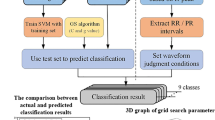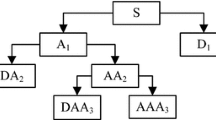Abstract
Heartbeat classification is central to the detection of the arrhythmia. For the effective heartbeat classification, the noise-robust features are very significant. In this work, we have proposed a noise-robust support vector machine (SVM) based heartbeat classifier. The proposed classifier utilizes a novel noise-robust morphological feature which is based on the conditional spectral moment (CSM) of the heartbeat. In addition to the proposed CSM feature, we have also employed the existing RR interval, the wavelets, and the higher-order statistics (HOS) based temporal and morphological feature sets. The noise-robustness test of the proposed CSM and all the studied feature sets is performed for the SVM based heartbeat classifier. Further, we have studied the significance of combining these temporal and morphological features on the final classification performance. For this purpose, the individual SVMs were trained for each of the feature set. The final classification is based on the ensemble of these individual SVMs. Various combining scheme such as sum, majority, and product rules are employed to ensemble the result of the individually trained SVMs. The experimental results show the noise-robustness of the proposed CSM feature. The proposed classifier gives improved overall performance compared to the existing heartbeat classification systems.

Similar content being viewed by others
References
Clifford GD, Azuaje F, McSharry P (2006) Advanced methods and tools for ECG data analysis. Artech house, London
Güler İ, Übeylı ED (2005) ECG beat classifier designed by combined neural network model. Pattern Recogn 38(2):199–208
Luz EJDS, Schwartz WR, Chávez GC, Menotti D (2016) ECG-based heartbeat classification for arrhythmia detection: a survey. Comput Methods Prog Biomed 127:144–164
Ye C, Kumar BV, Coimbra MT (2012) Combining general multi-class and specific two-class classifiers for improved customized ECG heartbeat classification. In Proc. Int. Conf. Pattern Recognition. IEEE, pp 2428–2431
Bazi Y, Alajlan N, AlHichri H, Malek S (2013) Domain adaptation methods for ECG classification. In Int. Conf. Computer Medical Applications. IEEE, pp 1–4
Singh P, Pradhan G (2020) A nw ECG denoising approach using generative adversarial network. IEEE/ACM Trans Comput Biol Bioinform. https://doi.org/10.1109/TCBB.2020.2976981
Chazal PD, O’Dwyer M, Reilly RB (2004) Automatic classification of heartbeats using ECG morphology and heartbeat interval features. IEEE Trans Biomed Eng 51(7):1196–1206
Ye C, Kumar BV, Coimbra MT (2012) Heartbeat classification using morphological and dynamic features of ECG signals. IEEE Trans Biomed Eng 59(10):2930–2941
De Lannoy G, François D, Delbeke J, Verleysen M (2012) Weighted conditional random fields for supervised interpatient heartbeat classification. IEEE Trans Biomed Eng 59(1):241–247
Mar T, Zaunseder S, Martínez JP, Llamedo M, Poll R (2011) Optimization of ECG classification by means of feature selection. IEEE Trans Biomed Eng 58(8):2168–2177
Zhang Z, Dong J, Luo X, Choi KS, Wu X (2014) Heartbeat classification using disease-specific feature selection. Comput Biol Med 46:79–89
Cortes C, Vapnik V (1995) Support-vector networks. Mach Learn 20(3):273–297
Byun H, Lee SW (2003) A survey on pattern recognition applications of support vector machines. Int J Pattern Recogn Artif Intell 17(03):459–486
Lannoy GD, François D, Delbeke J, Verleysen M (2010) Weighted SVMs and feature relevance assessment in supervised heart beat classification. In Int. Conf. Biomedical Engineering Systems and Technologies. Springer, pp 212–223
Ozcan NO, Gurgen F (2010) Fuzzy support vector machines for ECG arrhythmia detection. In Int. Conf. Pattern Recognition. IEEE, pp 2973–2976
Nasiri JA, Naghibzadeh M, Yazdi HS, Naghibzadeh B (2009) ECG arrhythmia classification with support vector machines and genetic algorithm. In European Symposium Computer Modeling and Simulation. IEEE, pp 187–192
Polat K, Güneş S (2007) Detection of ECG arrhythmia using a differential expert system approach based on principal component analysis and least square support vector machine. Appl Math Comput 186(1):898–906
Huang H, Liu J, Zhu Q, Wang R, Hu G (2014) A new hierarchical method for inter-patient heartbeat classification using random projections and RR intervals. Biomed Eng Online 13(1):1–26
Mondéjar VG, Novo J, Rouco J, Penedo M, Ortega M (2019) Heartbeat classification fusing temporal and morphological information of ECGs via ensemble of classifiers. Biomed Signal Process Control 47:41–48
Hao J, Wang C, Zhang H, Yang G (2020) Annealing genetic GAN for minority oversampling. arXiv preprint arXiv:2008.01967
Ye C, Coimbra MT, Kumar BV (2010) Arrhythmia detection and classification using morphological and dynamic features of ECG signals. In Int. Conf. Engineering in Medicine and Biology Society. IEEE, pp 1918–1921
Lin CC, Yang CM (2014) Heartbeat classification using normalized RR intervals and wavelet features. In Int. Symp. Computer, Consumer and Control. IEEE, pp 650–653
Korürek M, Doğan B (2010) ECG beat classification using particle swarm optimization and radial basis function neural network. Expert Syst Appl 37(12):7563–7569
Kutlu Y, Kuntalp D (2012) Feature extraction for ECG heartbeats using higher order statistics of WPD coefficients. Comput Methods Prog Biomed 105(3):257–267
Osowski S, Hoai LT, Markiewicz T (2004) Support vector machine-based expert system for reliable heartbeat recognition. IEEE Trans Biomed Eng 51(4):582–589
Loughlin PJ (2001) What are the time-frequency moments of a signal?. In Advanced Signal Processing Algorithms, Architectures, and Implementations XI, vol 4474, pp 35–45
Pan J, Tompkins WJ (1985) A real-time QRS detection algorithm. IEEE Trans Biomed Eng 32(3):230–236
Sayadi O, Shamsollahi MB (2009) A model-based bayesian framework for ECG beat segmentation. Physiol Meas 30(3):335–352
Hu YH, Tompkins WJ, Urrusti JL, Afonso VX (1993) Applications of artificial neural networks for ECG signal detection and classification. J Electrocardiol 26:66–73
Martínez JP, Almeida R, Olmos S, Rocha AP, Laguna P (2004) A wavelet-based ECG delineator: evaluation on standard databases. IEEE Trans Biomed Eng 51(4):570–581
Goldberger AL, Amaral LAN, Glass L, Hausdorff JM, Ivanov PC, Mark RG et al (2000) PhysioBank, PhysioToolkit, and PhysioNet: components of a new research resource for complex physiologic signals. Circulation 101:215–220
Yu SN, Chen YH (2009) Noise-tolerant electrocardiogram beat classification based on higher order statistics of subband components. Artif Intell Med 46(2):165–178
Lin CH, Du YC, Chen T (2008) Adaptive wavelet network for multiple cardiac arrhythmias recognition. Expert Syst Appl 34(4):2601–2611
Milgram J, Cheriet M, Sabourin R (2006) One against one or one against all: which one is better for handwriting recognition with SVMs?. In Int. workshop on frontiers in handwriting recognition. SuviSoft, pp 1–7
Author information
Authors and Affiliations
Corresponding author
Ethics declarations
Conflicts of interest
The authors declare that there is no conflict of interest regarding the publication of this article.
Ethical approval
This article does not contain any studies with human or animal subjects performed by any of the authors.
Additional information
Publisher's Note
Springer Nature remains neutral with regard to jurisdictional claims in published maps and institutional affiliations.
Rights and permissions
About this article
Cite this article
Singh, P., Pradhan, G. Noise robust automatic heartbeat classification system using support vector machine and conditional spectral moment. Phys Eng Sci Med 43, 1387–1398 (2020). https://doi.org/10.1007/s13246-020-00947-3
Received:
Accepted:
Published:
Issue Date:
DOI: https://doi.org/10.1007/s13246-020-00947-3




